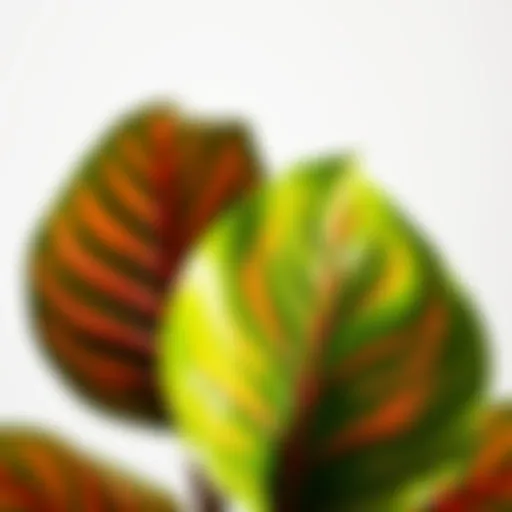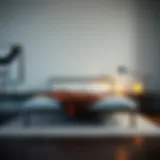Home Depot Planters and Pots: A Detailed Overview
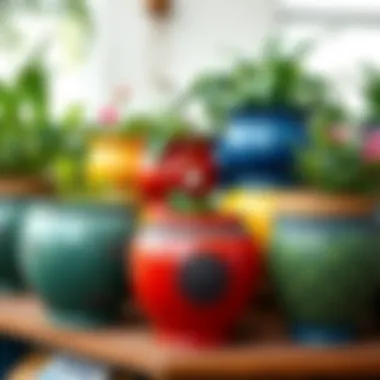

Intro
Home Depot has long been a favored destination for homeowners and DIY enthusiasts alike, thanks to its extensive inventory of gardening supplies. Among its standout offerings are a diverse array of planters and pots, which are vital in shaping the aesthetics and health of your plants. In this guide, we will navigate through various materials, designs, and sizes of planters and pots available at Home Depot. Our goal is to arm you with the proper knowledge so that whether you're nurturing indoor herbs or investing in vibrant outdoor blooms, you'll have what it takes to make informed choices.
Understanding the variety of planter types can be as crucial as the plants themselves. Selecting the right planter not only complements the visual elements of your space but also supports the plants' growth. As we delve into design trends, practical buying guides, and emerging sustainable practices, you will see just how interconnected these choices can be.
So grab your gardening gloves, and let’s dig into the colorful world of planters and pots at Home Depot!
Intro to Home Depot's Planters and Pots
When it comes to gardening, the right planter or pot can make all the difference. Home Depot, as a leading home improvement retailer, offers an extensive selection designed to cater to a wide array of gardening needs. This section aims to underscore the significance of their range of planters and pots, not just as decorative pieces but as crucial elements that support plant health and growth.
Choosing a planter is akin to choosing a home for your plants. It influences how air, water, and nutrients reach the roots, all essential for the vitality of the flora housed within. The diversity at Home Depot means there's something for everyone, whether you are an avid gardener or someone simply looking to spruce up your indoor space with a touch of green. The key aspects to consider when navigating Home Depot's offerings include the materials, designs, and usability of these containers.
Besides functionality, the aesthetic appeal cannot be overlooked. A well-chosen pot creates a focal point in any setting, enhancing the overall decor while offering a nurturing environment for your plants. Thus, understanding the various selections available at Home Depot enables homeowners to make informed decisions that align with both their gardening aspirations and style preferences.
In essence, exploring the planters and pots at Home Depot is about more than just plants; it's about fostering an environment where greenery can thrive, enhancing the beauty of your living space. By considering this guide, gardeners and enthusiasts alike can find the ideal containers that inspire growth and creativity in their gardening pursuits.
The Importance of Choosing the Right Planter
Selecting a planter isn’t just a simple choice; it plays a crucial role in the health, vitality, and overall aesthetic of your plants. Whether you're planting a delicate fern or a robust succulent, the right container can make a world of difference. Here, we’ll explore why this decision matters, diving into its effects on plant health and the visual ambience of your living spaces.
Impact on Plant Health
When it comes to plant health, the planter acts as a fundamental player in the growth equation. Choosing the correct size, material, and design ensures that your plants have the optimal environment to thrive.
- Size Matters: A planter that is too small can restrict root growth and lead to a stunted plant. Conversely, a planter that's overly large can hold too much moisture, causing root rot. Understanding your plant’s growth requirements can guide you toward selecting an appropriate size.
- Material Benefits: Different materials offer unique advantages for plant health. For instance, ceramic planters retain moisture well, which is perfect for plants that prefer a humid atmosphere. On the flip side, plastic pots are lightweight and generally allow for better drainage. Being aware of these characteristics can help you provide the best home for your plants.
- Drainage Dilemma: Proper drainage is non-negotiable for many plants. Without it, stagnant water can lead to diseases such as root rot, potentially harming your beloved greens. Therefore, choosing a planter with suitable drainage holes is vital.
The takeaway here is straightforward: the right planter provides your plants with the fundamental support needed for thriving growth.
Aesthetic Considerations
Beyond health, planters and pots contribute significantly to the visual appeal of your space. A well-chosen planter can elevate a room, turning an unassuming corner into a flourishing display of colors and textures.
- Style Compatibility: Home Depot offers a myriad of styles, from sleek modern designs to rustic finishes. Selecting a planter that aligns with your personal style or existing decor can add coherence to the environment. For instance, a minimalist pot can emphasize the beauty of a single plant, while a charming, whimsical design can create a more playful vibe.
- Color Coordination: Color plays a vital role in setting the mood. Choosing a planter that complements wall colors or other decor items can create a harmonious look. Bright, vibrant pots can energize a space, while muted tones often lend a sense of calm.
- Layering Textures: Incorporating various materials can create depth in decoration. Mixing ceramic, metal, and wood planters can result in a rich tapestry of textures that capture the eye. Each planter can tell its story through its material and design, enhancing your garden or interior space.
In summary, the aesthetic aspect of choosing the right planter is not simply optional; it's a key feature in making your environment visually inviting.
"Choosing the right planter is much like choosing a frame for a painting; it compliments the beauty within and enhances the entire presentation."
Focusing on these aspects can transform the simple act of planting into a more fulfilling and enjoyable experience.
Material Options for Planters and Pots
When it comes to planters and pots, the choice of material is not just about aesthetics. It plays a crucial role in plant growth, durability, and how well the planter suits your environment. Various materials each have their set of benefits and considerations, influencing both the practical use of the planter and its visual appeal in your space. Let's delve into some of the most popular options available at Home Depot, shedding light on their characteristics and suitability for different gardening needs.
Ceramic Planters
Ceramic planters are often favored for their classic look and variety of designs. They can be quite decorative, with finishes that range from glossy to matte, and prints that can fit any theme. One major benefit is that these planters help maintain consistent moisture since they are porous. This means they allow some evaporation, which can be beneficial for plants that prefer slightly drier conditions.
However, there's more to ceramic than just appearance. They are generally heavier than other materials, which might be advantageous in windy areas, as they are less likely to tip over. On the flip side, their heft can be a drawback for moving them around, especially when filled with soil and plants. Additionally, ceramic planters can crack in freezing weather, so consider this if you plan to use them outdoors.
Plastic Pots
Plastic pots are the unsung heroes of modern gardening. They are lightweight, affordable, and incredibly versatile. One of the biggest advantages of plastic is its resistance to breakage; they can withstand drops or knocks without shattering like ceramic. This feature makes them particularly appealing for outdoor settings where accidents might occur.
Furthermore, plastic retains moisture well, which can cut down on frequent watering—ideal for busy gardeners. They come in a myriad of colors and designs, allowing for personalization without breaking the bank. Yet, not all plastics are created equal. Some can degrade under UV rays from the sun, leading to fading or brittleness over time. When selecting plastic pots, it might be worth looking for UV-resistant options to ensure longevity.
Metal Containers
Metal containers bring a unique flair to gardening, offering a contemporary aesthetic that can make a statement in any garden or indoor space. Options like galvanized steel or aluminum are sturdy and can resist rusting if treated properly. They also heat up quickly in the sun, which is favorable for plants that thrive in warmer conditions.
On the downside, metal pots can overheat and potentially harm sensitive plant roots, so using insulation or lining the interior with another material might be necessary. They tend to be heavier and more expensive than their plastic counterparts, so consider your budget and lifting capabilities when choosing these stylish planters. Still, if you’re after a chic and industrial look, metal containers are hard to beat.
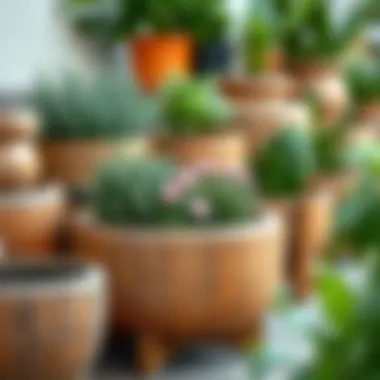

Eco-Friendly Alternatives
With the rising awareness of sustainability, many are opting for eco-friendly planters. These can include biodegradable pots made from materials like coconut coir, bamboo, or recycled paper. These planters break down over time, allowing the plants to thrive without being hindered by ownership.
Another option is pots made from recycled plastics or upcycled materials, combining environmental consciousness with practical use. These choices can significantly reduce plastic waste while giving you a unique style. However, the longevity can vary greatly between types, so it’s important to weigh the benefits of sustainability against the durability of these options.
Design Styles Available at Home Depot
Choosing the right planter is more than just practicality; it’s about harmonizing your plants with your space. Design styles available at Home Depot cater not only to the plant's needs but also meld with your home’s aesthetic. With various trends, materials, and colors, planters can serve as artistic statements while nurturing your green friends. This section will delve into three main design styles that capture the imagination and blend effortlessly into your environment.
Modern and Minimalist
Modern and minimalist designs focus on simplicity and elegance. Think clean lines, neutral colors, and a refined, understated look. This style is worked into the fabric of many homes today, especially those with a contemporary twist. Planters in this category often come in geometric shapes and monochromatic palettes.
A key benefit of these planters is their versatility. They can complement a wide variety of plants, creating a breathtaking contrast between lush greenery and sleek design. Moreover, their understated nature ensures that they draw the eye to the plants, rather than overpowering them. Consider ceramic or fiberglass options for a polished finish that speaks to modern aesthetics. When arranging a modern living space, integrate planters with metallic accents like galvanized steel or matte black, creating a chic environment that whispers sophistication.
Rustic Charm
Rustic charm offers a heartwarming contrast to the sleekness of modern styles. This design leans into the warmth of nature, featuring materials like reclaimed wood, terracotta, and even wicker. Imagine a lovely wooden planter with aged finishes and textured surfaces that evoke a sense of nostalgia. These planters often enhance the organic feel of your plants, making them feel at home.
Houses or gardens adorned with rustic planters can exude a cozy, welcoming atmosphere. Whether placed on a porch, patio, or garden, they carry a sense of history and story. Perfect for herbs, wildflowers, and lush greens, these planters bring a bit of country living into urban spaces. Homeowners should also consider pairing these charming planters with seasonal decorations, creating a continuously evolving display to reflect the changing seasons.
Whimsical Designs
Whimsical designs spark imagination and joy, capturing the essence of creativity in gardening. These planters often feature playful shapes, vibrant colors, and artistic craftsmanship, allowing your plants to express personality as well. You might find pots shaped like animals, faces, or even abstract forms, each one telling a different story.
Incorporating whimsical designs into your space can elevate its mood, making it feel lively and inviting. They suit various environments, especially children’s areas or themed gardens. While these planters might not fit into every decor style, they certainly create focal points in any garden or indoors, making onlookers smile. Consider adding them to a balcony or a small patio area for a stunning visual impact that doesn’t require much space.
Whimsical planters can uplift your gardening game, transforming everyday plants into delightful artworks.
Using a combination of these styles can yield a unique presentation, showcasing your personal taste and passion for gardening. Each style—modern and minimalist, rustic charm, or whimsical—carries its own significance and caters to diverse preferences. Homeowners and design enthusiasts alike benefit from understanding these styles, allowing for informed choices when selecting planters that not only support plants but enhance spaces as well.
Choosing the Right Size for Your Planter
Choosing the right size for your planter is more crucial than many realize. It’s not just about aesthetics, though that plays a part. Getting the size right can have a significant impact on the health and vitality of your plants. It’s like finding the right shoe size; if it’s too tight or too loose, you’re not going to be comfortable—or in this case, healthy.
An appropriately sized planter allows for optimal root growth, promotes healthy drainage, and creates a focused space for plants to thrive. Understanding both the growth patterns of your plants and your specific environment can help in making this choice easier. When you select a planter that suits the needs of your plants, you set the stage for flourishing growth.
Understanding Plant Growth
To begin with, a plant's growth pattern is shaped by its species, the conditions in which it thrives, and ultimately, the space it occupies. Some plants have extensive root systems, while others may require less depth. For example, a fiddle leaf fig typically prefers a deeper planter due to its large root structure, while a snake plant grows well even in a shallow pot.
- Rescue Plants from Root Bound Conditions: If a plant becomes root-bound, which happens when roots grow densely and start circling the pot, it can hinder water flow and nutrient uptake. Choosing a larger planter can help avoid this issue.
- Room for Growth: A good rule of thumb is to select a pot that is 1-2 inches wider in diameter than the existing pot for smaller plants and up to 4 inches for larger specimens. This extra room allows roots to expand without excessive restriction.
When the growth patterns of various plants are understood, the choice of planter size becomes a more informed decision, ensuring that they grow comfortably.
Space Considerations
Now let’s talk about space. The area you have available will inevitably influence your planter size choices. A common mistake many make is underestimating how much room a plant actually needs.
For individuals with limited space, like those in apartments, utilizing vertical gardens or tiered stands can maximize surface area for plants without taking up too much floor space. However, if the space is cramped, larger planters could feel overwhelming and disorganized. Striking a balance is essential. Here are some space considerations to keep in mind:
- Location: If your space has bright sunlight during the day, ensure your planter can adequately hold moisture without drying out too fast in that heat.
- Accessibility: Large pots can become cumbersome. If you have many plants, you should choose sizes that are manageable for regular maintenance.
- Proportion: Make sure the planter fits within your designated area without looking out of place. A gigantic pot next to a small fern might crowd it or overpower your overall design aesthetic.
Usage Scenarios for Planters and Pots
When it comes to selecting planters and pots from Home Depot, understanding the usage scenarios is essential. It's not just about the aesthetics of your garden or home interior; it's also about ensuring that the environment you create is suitable for the plants that will inhabit those spaces. Planters serve both functional and decorative purposes, making careful selection a critical aspect of any planting project. From enhancing indoor air quality to beautifying outdoor spaces, the importance of proper usage cannot be overstated.
By exploring various usage scenarios for planters and pots, homeowners, designers, and enthusiasts can make informed decisions based on the unique characteristics of each situation.
Indoor Gardening
Indoor gardening has seen a surge in popularity, especially among urban dwellers who may have limited outdoor space. Planters for this scenario not only serve to house plants but also contribute significantly to the overall ambiance of a room. When selecting indoor planters, consider the type of plants you plan to grow. For instance, herbs like basil or parsley thrive in smaller containers with excellent drainage, while larger leafy plants, such as fiddle-leaf figs, will benefit from wider, deeper pots.
Benefits of Indoor Planters:
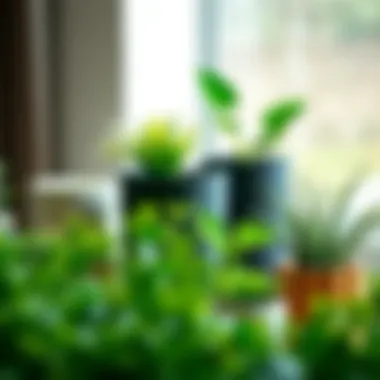

- Air Purification: Many indoor plants, especially varieties like snake plants and peace lilies, improve indoor air quality by filtering toxins.
- Humidity Control: They can help regulate humidity levels, which is beneficial for both plants and the occupants of the space.
- Aesthetic Appeal: Stylish planters can complement the interior decor, adding a splash of color or texture.
In this context, materials like ceramic and metal can add elegance, while plastic options provide lightweight portability.
Outdoor Decor
Outdoor spaces often call for planters that can withstand the elements, while still being visually appealing. When using planters outdoors, durability and style must go hand in hand. Many choose ceramic or metal planters, which can resist moisture and provide a refined look. Moreover, outdoor planters can be used to create defined spaces, such as seating arrangements or walkways.
Considerations for Outdoor Planters:
- Weather Resistance: Opt for materials that can endure sun, rain, and temperature fluctuations.
- Size and Scale: Larger planters can act as focal points, while smaller ones might work better in clusters or as border highlights.
Placing vibrant flowers or climbing plants in these pots can really elevate an outside living area. A blue ceramic pot with yellow flowers, for example, can create a stunning visual contrast.
"Outdoor planters serve as a critical design element, guiding the eye and enriching outdoor landscapes."
Balcony and Small Spaces
For those living in apartments or condos, every inch counts. Here, planters are not just functional; they are vital for maximizing precious square footage. Space-saving pots or vertical planters are excellent for making the most out of limited areas. Herbs, succulents, and compact flowers can thrive in these specially designed containers.
Advantages of Utilizing Planters in Small Spaces:
- Vertical Gardening: Wall-mounted planters can provide greenery without taking up precious floor space.
- Modular Options: Stackable or hanging planters can create layers of plants, adding depth to what might otherwise feel flat.
Choosing pots that align with your space helps create a cohesive look while still allowing for a thriving plant collection. For example, a series of small hanging pots can turn a drab balcony railing into a vibrant display of life.
Caring for Your Planters and Pots
Taking care of your planters and pots is not merely a chore; it’s an essential part of fostering a thriving indoor or outdoor garden. Many homeowners and gardening enthusiasts might think that once the plant is in the pot, the hard work is done. However, caring for your planters and pots encompasses various practices that ensure both the aesthetic and functional aspects of gardening are maintained.
The right care can prolong the life of your pots, keep your plants healthy, and enhance the overall look of your spaces. Indoor plants thrive with proper moisture levels while outdoor pots can withstand the elements through diligent maintenance. Understanding how to care for planters also contributes to sustainability, where longevity is prioritized over replacement.
Watering Techniques
Watering is a balancing act—a little too much and you risk drowning your plant; too little and it can wither away. You should consider factors such as the plant species, the season, and pot size when settling on your watering routine.
- Know Your Plant Needs: Different plants have unique watering requirements. Succulents and cacti prefer drier soil, while ferns thrive in more humid conditions. If you're unsure, research the specific needs of your plants prior to watering.
- Check the Soil: A quick poke with your finger can be revealing. Stick your finger about an inch into the soil; if it feels dry, it’s time to water. If it’s still moist, leave it for another day or two.
- Water Evenly: When you do water, ensure that the entire pot receives moisture. Pour slowly around the edges and allow the water to seep through the drainage holes at the bottom. This helps in developing a strong root system.
- Time It Right: Morning is often the best time to water, allowing any excess moisture to evaporate as the sun rises. Avoid late evening watering, which can promote mold growth due to prolonged dampness.
Drainage Needs
Proper drainage is crucial for the health of your plants, especially when using planters. Without it, roots can suffocate and rot, leading to wasted time and effort.
- Choose the Right Pot: Look for pots that have drainage holes to prevent stagnant water. Home Depot offers a selection of planters specifically designed with optimal drainage solutions.
- Consider Potting Mix: Your choice of soil can impact drainage. Add materials such as perlite, sand, or coco coir to standard potting mix to enhance its drainage properties. In doing so, you create a well-aerated environment that roots will love.
- Ensure Regular Maintenance: Occasionally, check drainage holes to make sure they are not clogged with soil or debris. A good practice is to tilt the pot and observe how well water flows out. If you notice pooling at the bottom, it's time to adjust your soil or consider repotting.
"The groundwork for all happiness is good health." – James Freeman Clarke
By understanding the watering techniques specific to each plant and ensuring proper drainage, you can take significant strides in caring for your planters and pots. This not only protects your plants but also adds to your overall gardening joy.
Trends in Planters and Pot Design
In recent years, the world of gardening and plant care has seen a shift in style, function, and eco-friendliness. Home Depot's range of planters and pots reflects these trends, allowing homeowners and design enthusiasts to not only beautify their spaces but also embrace more sustainable practices. This section will discuss key designs that are making waves in the industry today, emphasizing why they matter.
Sustainable Materials
Sustainability is the name of the game now. With growing concern over environmental issues, many consumers prioritize eco-friendly products. Home Depot responds to this demand by offering planters made from sustainable materials such as bamboo, recycled plastics, and even biodegradable alternatives. Here are some benefits of choosing sustainable planters:
- Reduced Environmental Impact: Opting for products made from recycled or renewable resources lessens one's carbon footprint.
- Longer Lifespan: Many sustainable materials are durable, meaning that they will last season after season without deteriorating.
- Aesthetic Appeal: Many of these products have unique textures and colors that can enhance the look of any garden or indoor setup.
When selecting a planter, consider what materials align with your values. For instance, if you care about reducing waste, look for pots crafted from ocean plastic or reclaimed composite materials.
"Choosing planters made of recycled materials is not merely about aesthetics; it’s a statement of one’s commitment to the planet."
Smart Planters
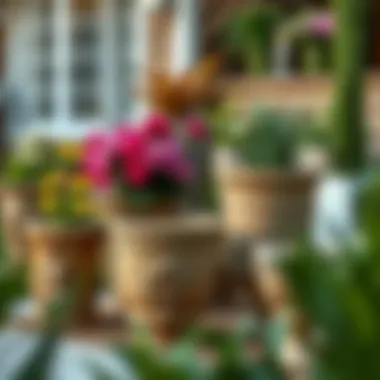

The integration of technology in gardening is more than just a fad; it’s a trend that’s here to stay. Smart planters provide features such as self-watering systems, sensors that monitor soil moisture, and connectivity to mobile apps for an enhanced gardening experience. Here are some key aspects of smart planters:
- Convenience: Effortless plant care with automatic watering and real-time monitoring.
- Optimal Growth Conditions: Utilizing technology ensures plants receive just the right amount of water and nutrients.
- Data-Driven Insights: Many smart planters analyze growing conditions and provide actionable tips to improve plant health.
Imagine a busy schedule combined with a passion for plants. A smart planter can remind you when to add water without needing to check daily. These advancements make it easier for both novice gardeners and experienced horticulturists to enjoy thriving plants without the stress. As these technologies improve, we can expect a more interactive and informed approach to gardening, catering to individuals of all skill levels.
Comparative Analysis of Brands
In the landscape of gardening, the selection of planters and pots isn't just about aesthetics or plant health; it's also about understanding the brands that manufacture these products. A comparative analysis of brands illuminates how various retailers stack up against each other, especially in terms of quality, design, and customer service. Such an examination offers homeowners, designers, DIY enthusiasts, and retailers a clearer picture of where to invest their resources, and it allows them to make more informed choices, ultimately enhancing the gardening experience.
Brand reputation is pivotal here. Home Depot, with its long-standing presence in the market, offers a vast array of options for plant lovers. But it also faces competition from other garden centers and online retailers. By looking closer at the features and benefits each brand provides, one can discern which options are worth their weight in soil.
Home Depot vs. Competitors
When comparing Home Depot to its rivals, there are several factors to take into account:
- Product Variety: Home Depot boasts a wide array of planters—from ceramic to eco-friendly options. Competitor brands might specialize in certain materials or styles, which can limit selection. However, some niche retailers may offer unique designs that appeal to specific tastes.
- Price Point: Generally, Home Depot aims to cater to a broad market with budget-friendly options without compromising on quality. On the other hand, some brands may focus on luxury items that come with a higher price tag, reflecting their craftsmanship.
- Customer Experience: Home Depot provides the convenience of shopping in-store and online. They also have a solid return policy and customer support, which might not always be the case with smaller competitors. Conversely, specialized retailers often provide a more personalized shopping experience with knowledgeable staff ready to assist.
- Sustainability Practices: With the growing trend for environmentally friendly gardening, Home Depot has begun to adopt more sustainable practices regarding their suppliers and product lines. However, some brands are more advanced in this area, offering exclusively eco-friendly products, appealing to that conscientious segment of gardeners.
"Understanding the landscape of planters and pots involves more than just picking one up off a shelf. It's about knowing which brands stand behind their products and what philosophies guide them."
All these elements are crucial for anyone considering investing in planters and pots. A well-rounded knowledge not only leads to better purchases but can also improve the overall gardening journey. After all, each planter does not merely hold soil; it holds the potential for thriving plant life.
Customization Options at Home Depot
Customization options for planters and pots at Home Depot are not just a luxury; they are an opportunity to express individual style and meet specific gardening needs. With a plethora of choices available, shoppers can tailor their selections to fit personal aesthetics while ensuring functionality. These options allow for an elevated gardening experience, where each planter serves as an extension of the homeowner's personality and gardening philosophy.
One significant benefit of customization is the ability to align planters with the surrounding decor of the home or garden. For instance, a bright blue ceramic pot can add a pop of color to an otherwise muted outdoor space, while earthy-toned pots can create a more harmonious appearance among lush greenery. Home Depot's offer of personalized styles enables customers to choose materials, colors, and designs that best reflect their vision.
Furthermore, customization enhances the functionality of planters. For example, homeowners can select pot sizes that cater specifically to the growth needs of their plants. A larger pot can accommodate root growth while a smaller one may be ideal for plants that prefer being root-bound. Being able to choose specific drainage options, plant depths, and widths also leads to healthier plants.
Personalized Styles
Creating personalized styles is a key facet of the customization offerings at Home Depot. This is not merely about slapping a coat of paint on a bland pot; it's about aligning the planter with the homeowner's lifestyle and preferences. A growing trend is using decorative elements such as stencils, paints, or even decals to turn standard planters into unique statements.
Selecting specific materials also contributes to personal style. Home Depot provides an assortment of options, from the sleekness of fiberglass to the rugged charm of distressed wood. Each material can evoke different feelings. For instance, wood planters give off a cozy, rustic vibe, while sleek metal pots exude modern sophistication. This variety allows individuals to choose what resonates most with them,
Additionally, considering the existing decor of the home or garden space is essential. For instance, if the home decor leans towards a more coastal aesthetic, opting for light, airy ceramic pots with oceanic colors can tie the entire look together nicely.
DIY Enhancement Ideas
If you’re looking to roll up your sleeves, DIY enhancement ideas can take standard planters from drab to fab in no time. Personalizing your gardening setup doesn’t have to be limited to ready-made options. With a little creativity and effort, you can make each planter a work of art.
- Upcycling: Consider using old containers—like tin cans or even wooden pallets— and transforming them into unique planters. Applying paint or varnish can breathe new life into these items, making them an interesting conversation starter in your garden or home.
- Accessorizing: Adding embellishments such as beads, ropes, or even fabric can spruce up the standard pot. For example, wrapping jute rope around the base of a terracotta pot can give it a rustic, beachy feel that aligns with outdoor aesthetics.
- Artistic Expression: Don’t shy away from painting pots with bright colors or patterns. Creating hand-painted pots with floral designs can be an enjoyable weekend project and can significantly enhance the aesthetic appeal of indoor spaces as well.
"Customization is key when it comes to gardening; it allows you to not only bring your plants to life but also your personal expression."
These DIY ideas encourage a sense of ownership and creativity. Plus, they allow for the flexibility of changing styles to match the seasons or your mood. In doing so, planters can continually evolve, adding a fresh take to garden and home decor.
By exploring the customization options at Home Depot, homeowners can significantly enhance both their gardening experience and the overall look of their spaces.
Resources to Explore Further
- Home Depot Customization Options
- Gardening DIY Ideas
- Creative Planter Ideas on Reddit
- Sustainable Gardening Practices
Culmination
In wrapping up this extensive guide on Home Depot's planters and pots, it's crucial to reflect on the multifaceted nature of your planting choices. This isn't just about acquiring containers; it's a matter of understanding how these selections can impact your gardening success and aesthetic appeal at home.
When deciding on the right planter, think about the material, size, and design style that resonates with your personal taste and complements the environment where your plants will reside. Each type of pot offers its own benefits—ceramic containers can enhance humidity, while eco-friendly options align more closely with sustainable practices.
Care and maintenance are an essential part of the equation as well. Proper watering techniques and assessing drainage needs are pivotal in ensuring that your plants thrive, and these practical aspects shouldn't be overlooked. A well-maintained planter adds not only beauty to your space but also vitality to your plants.
Furthermore, customizing your planting experience with personalized styles or DIY enhancements can elevate your gardening game. It's these unique touches that transform simple pots into standout garden pieces.
Ultimately, this guide serves as a toolkit for homeowners and design enthusiasts keen on enhancing both their indoor and outdoor spaces. By exploring the vast array of options available at Home Depot, you can choose planters and pots that not only fit the specific needs of your plants but also make a significant impact on the overall atmosphere of your home.
As we grow more aware of the importance of sustainable gardening, selecting the right planter becomes not just a practical choice but an eco-conscious decision. Taking the time to explore these factors will lead you to enrich your experience in gardening, creating spaces that reflect both beauty and thoughtful care. Remember, in the world of gardening, the perfect planter is not just a vessel; it's an investment in the health of your plants and the aesthetic of your space.
"A planter is not just a home for roots; it is a starting point for growth and a splash of character in any room."
By paying attention to these various elements, you’re not just planting seeds; you’re crafting an environment where flora can flourish and beauty can shine.









